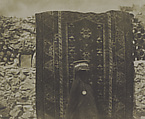Coiffure des Femmes de Nazareth
Maxime Du Camp French
Not on view
In 1849–51 Du Camp traveled to Egypt and the Near East to make a photographic survey of ancient monuments and sites. His companion was the as yet unknown writer, Gustave Flaubert. Upon his return to France, Du Camp selected 125 views for Egypte, Nubie, Palestine et Syrie, an album printed by the Blanquart-Evrard establishment and published in Paris in 1852. The groundbreaking work was the first travel book to be illustrated entirely with actual photographs instead of reproductions.
This photograph was not included in the 1852 publication but comes from a small album printed separately from the edition. Despite the artist's intentions to create clear and legible records of his visit to the Holy Land, here Du Camp composed a somewhat ambiguous, if fascinating image. What at first seems to be a study of a veiled woman standing before a hanging rug and wearing an elaborate coin-studded headdress, ultimately seems to be a still life of an ethnographic souvenir propped on a cloaked mount. Despite our romantic cravings for the exotic, no eyes hide in the dark triangular shadow cast by the headdress. It is nothing more than a well-crafted mirage constructed in part by the intense desert sun and by a pair of romantic Frenchmen known to have bought elaborate hairdos as keepsakes of their journey.
Due to rights restrictions, this image cannot be enlarged, viewed at full screen, or downloaded.

